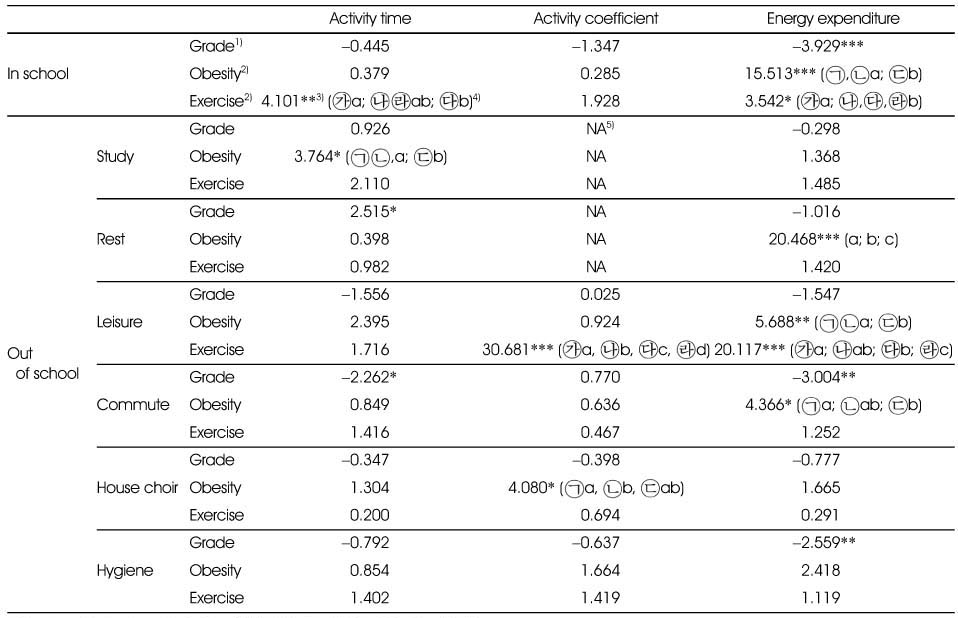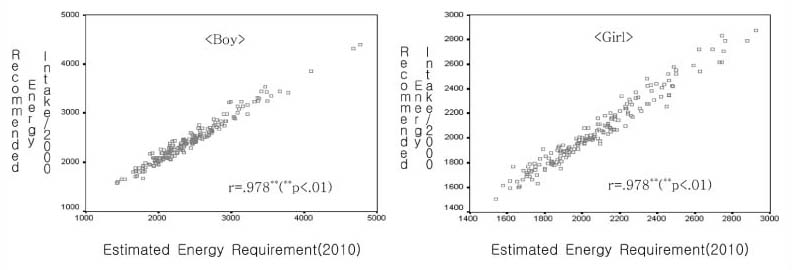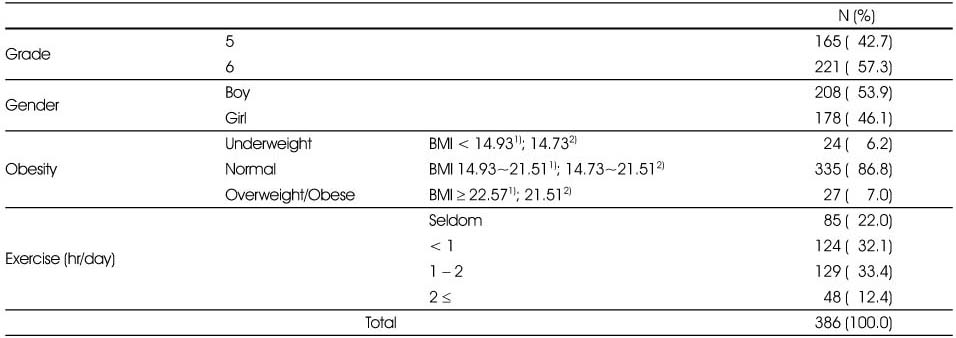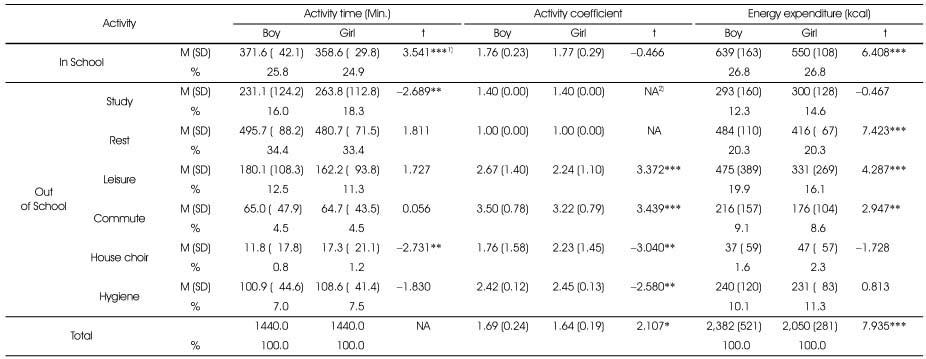Articles
- Page Path
- HOME > Korean J Community Nutr > Volume 16(2); 2011 > Article
-
Original Article
- The Analysis of Activity Energy, Total Energy, and Estimated Energy Expenditures in 5th and 6th Grade Primary School Students
- Mi-Jeong Kim, Hyeon-Ju Na, Youngnam Kim
-
Korean Journal of Community Nutrition 2011;16(2):195-205.
DOI: https://doi.org/10.5720/kjcn.2011.16.2.195
Published online: April 30, 2011
Sinmuk Primary School, Kyeunggi Do, Korea.
1Imae High School, Kyeunggi Do, Korea.
2Department of Home Economics Education, Korea National University of Education, Chungbuk, Korea.
- Corresponding author: Youngnam Kim, Department of Home Economics Education, Korea National University of Education, Darak-ri, Gangnae-myeon, Chungwon-gun 363-791, Chungbuk, Korea. Tel: (043) 230-3709, Fax: (043) 231-4087, youngnam@knue.ac.kr
Copyright © 2011 The Korean Society of Community Nutrition
- 1,013 Views
- 0 Download
- 3 Crossref
Abstract
- This study was conducted to investigate the time spent, activity coefficient and energy expenditure on 7 different types of activity. Total of 386 5th and 6th grade primary school boys and girls in Seoul participated in this study. The participants spent 8 hrs for rest, 4 hrs for out of school study, 3 hrs for leisure, 1 hr 45 mins. for hygiene, 1 hr for commute, and 15 mins. for house choir activity in the day of 6 class hours. The average activity coefficient of 1 day for boys and girls were 1.69 and 1.64, respectively. The TEEs were 2,382 kcal and 2,050 kcal for boys and girls, respectively. The energy cost for study related activity (in school and study activities) was 40% of the TEE, and for rest 20%, for commute 9%, and for hygiene 10% of the TEE. The energy cost for house choir was only about 2% of TEE. The 91.2% participant's EER was higher than the EER shown in the table of 2010 DRI for Koreans. When the participant's EER was compared with the energy allowance calculated by the method in 2000 RDA for Korean, 81.6% was in the range of ± 5%, and the correlation coefficients between the 2 values were 0.981 for boys and 0.978 for girls, which means high agreements.
- 1. Kim B. A study on the primary school students' daily activity contents and energy consumption. 2005; Busan National University of Education; 31-45 MS Thesis.
- 2. Kim EK, Kim EK, Song JM, Choi HJ, Lee GH. Assessment of activity coefficient, resting energy expenditure and daily energy expenditure in elementary school children. J Korean Diet Assoc. 2006; 12(1): 44-54.
- 3. Kim EK, Kim GS, Park JS. Comparison of activity factor, predicted resting metabolic rate, and intakes of energy and nutrients between athletic and non-athletic high school students. J Korean Diet Assoc. 2009; 15(1): 52-68.
- 4. Kim MJ, Na HJ, Kim Y. Total energy expenditure difference by the class hours in 5th & 6th grade primary school students. Korean J Teach Educ. 2010; 26(6): 55-73.
- 5. Kim SH. A study on time frame structure of children. Child Stud. 1996; 5: 40-52 Institute for Child Study in Kosin University.
- 6. Kim Y. National research council. Recommended dietary allowances. 1992; 10th Edition. Seoul: Suhaksa; 246-247.
- 7. Kim Y, Na HJ. The estimation of the daily energy expenditure of Korean adolescents. Korean J Community Nutr. 2003; 8(3): 270-279.
- 8. Korea Centers for Disease Control and Prevention. The Korean Pediatric Society. 2007 Infantsadolescent's growth standards. 2008.
- 9. Lee GH. Assessment of physical activities, energy expenditures and validity of predicted resting metabolic rates in university students. 2006; Graduate School of Industrial Technology, Kangnung National University; MS thesis.
- 10. Lee HM, Kim EK. Assessment of daily steps, physical activity and activity coefficient of the elementary school children in the rural area. Korean J Community Nutr. 2007; 12(3): 361-371.
- 11. Ministry of Health & Welfare. The Korea Nutrition Society. Korea Food & Drug Administration. Dietary reference intakes for Koreans. 2010; First revision. 17-46.
- 12. Na HJ. The analysis of adolescents energy expenditure and development of energy expenditure evaluation web-based learning system. 2003; Korea National University of Education; 25-28 Ph.D thesis.
- 13. Park E. The evaluation of energy expenditure of weekday and weekend in elementary school students. 2006; Korea National Sport University; MS thesis.
- 14. The Korean Nutrition Society. Recommended dietary allowances for Koreans. 2000; 7th revision. 21-42.
- 15. The Korean Nutrition Society. Dietary reference intakes for Korean. 2005; The Korean Nutrition Society; i-vi. 19.
- 16. Yoon JS, Kim KJ, Kim JH, Park YS, Koo JO. A study to determine the recommended dietary allowance of energy and to develop practical dietary education program for Korean adults. Report of Ministry of Health and Welfare National Health Promotion Foundation Programs. 2002; 121.
REFERENCES



Figure & Data
REFERENCES
Citations

- Energy expenditure measurement of various physical activity and correlation analysis of body weight and energy expenditure in elementary school children
Jae-Hee Kim, Hee-Ryoung Son, Jung-Sook Choi, Eun-Kyung Kim
Journal of Nutrition and Health.2015; 48(2): 180. CrossRef - Physical activity level, total daily energy expenditure, and estimated energy expenditure in normal weight and overweight or obese children and adolescents
Myung Hee Kim, Eun Kyung Kim
Korean Journal of Nutrition.2012; 45(6): 511. CrossRef - Criterion Development of 4 Activity Levels for Estimated Energy Requirement Calculation for Primary School Students
Mi-Jeong Kim, Hyeon-Ju Na, Youngnam Kim
Korean Journal of Community Nutrition.2011; 16(3): 307. CrossRef

Fig. 1
General characteristics of the subjects
1) for boy; 2) for girl
Physique of the subjects
1) Mean (SD)
Activity time & coefficient, and energy expenditure by gender in 7 different activities
1) *: P < 0.05, **: P < 0.01, ***: P < 0.001
2) NA: Non Applicable
Results of statistically significant difference evaluation of activity time, activity coefficient, and energy expenditure by the subject's grade, gender and obesity
1) t-value, 2) F-value, 3) *: P < 0.05, **: P < 0.01, ***: P < 0.001
4) Scheffe posteriori test: ㉠ underweight, ㉡ normal, ㉢ overweight/obese; ㉮ seldom, ㉯ < 1 hr/day ㉰ 1~2 hr/day, ㉱ 2 ≤ /day exercise
5) NA: Non Applicable
Distribution of total energy expenditure (TEE) of the subjects by the calculation formula in DRI for Koreans (first revision, 2010)
1) N (%)
Boy: 1,403 kcal~4,747 kcal; Girl: 1,512 kcal~2,720 kcal
Percent difference between the EER in the table of DRI for Koreans (2010) and EER of the subjects
1) N (%)
Reference EER (9 - 11 years): 1,900 kcal/day for boy; 1,700 kcal/day for girl (DRI for Koreans, first revision, 2010)
The difference between the recommended energy intakes by the estimation methods in RDA for Koreans (7th revision, 2000) and DRI for Koreans (first revision, 2010)
1) N (%)
1) for boy; 2) for girl
1) Mean (SD)
1) *: P < 0.05, **: P < 0.01, ***: P < 0.001 2) NA: Non Applicable
1) t-value, 2) F-value, 3) *: P < 0.05, **: P < 0.01, ***: P < 0.001 4) Scheffe posteriori test: ㉠ underweight, ㉡ normal, ㉢ overweight/obese; ㉮ seldom, ㉯ < 1 hr/day ㉰ 1~2 hr/day, ㉱ 2 ≤ /day exercise 5) NA: Non Applicable
1) N (%) Boy: 1,403 kcal~4,747 kcal; Girl: 1,512 kcal~2,720 kcal
1) N (%) Reference EER (9 - 11 years): 1,900 kcal/day for boy; 1,700 kcal/day for girl (DRI for Koreans, first revision, 2010)
1) N (%)

 KSCN
KSCN





 Cite
Cite


